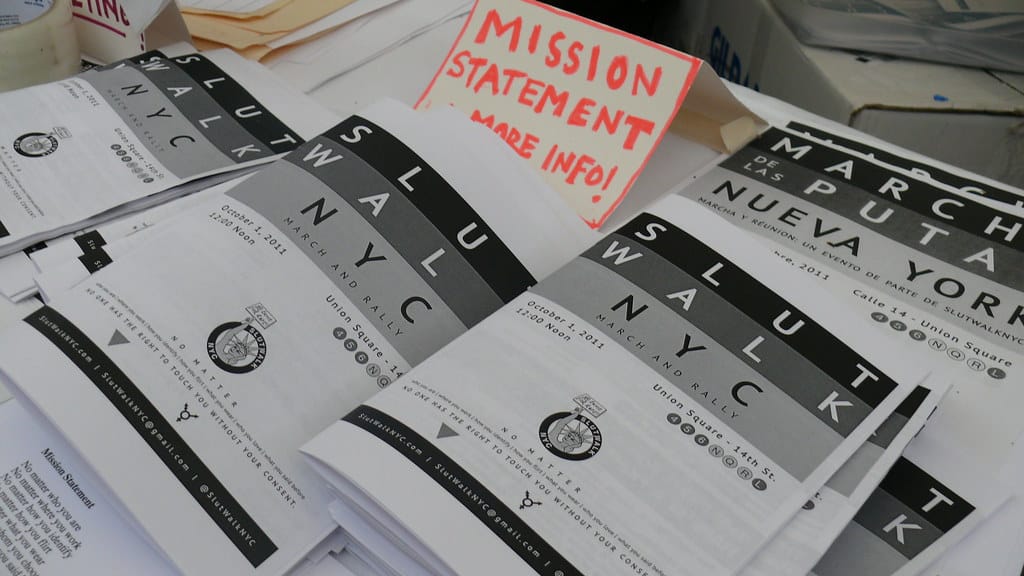Are you wondering how to write a mission statement?
In the realm of business, a mission statement articulates much more than just a buzzword. It's a concise statement and description of an organization's purpose, values, and overarching goals.
Whether you're an entrepreneur, startup founder, business student, or small business owner, crafting a powerful mission statement is crucial.
It serves as the guiding star for your business, informing every decision and action you take.
Remember, a mission statement summarizes your company vision, why your organization exists, and that you're a customer centric company. The perfect mission statement is vital for your brand.

What is a Mission Statement?
A mission statement is a fundamental document that articulates the core purpose of a business or organization. It defines the reason for its existence, outlining the values and principles that guide its actions and decisions.
Looking for an experienced Wordpress Development company?
Typically, a mission statement answers key questions such as what the organization does, whom it serves, and what distinguishes it from competitors.
By providing clarity of direction and focus, a well-crafted mission statement not only communicates the organization’s intentions to employees and stakeholders but also fosters alignment and motivation among team members, helping to create a cohesive organizational culture.

Importance of a Clear and Effective Mission Statement
A well-crafted mission statement can make all the difference.
It not only guides internal decision-making but also communicates your business's core values and purpose to internal and external audiences, including potential customers and investors.
A strong mission statement celebrates and helps to foster brand loyalty, create a genuine connection with your target audience, and provide a clear direction for your company's future.

Step-by-Step Guide | How to Write a Mission Statement
1. Explain Your Company's Offering
Begin by clearly articulating what your company offers.
This could be a product, a service, or a combination of both. Make sure this description is straightforward and easily understood.
Example:
“We offer a subscription service that delivers freshly roasted coffee beans to your doorstep every month.”
2. Identify Core Values
Next, identify the core values that are central to your business.
These values should reflect what your organization stands for and what it aims to achieve beyond just making a profit.
Example:
“Our core values include sustainability, quality, and community.”
3. Align Offering with Values
Now, connect how your company's offering aligns with these core values.
This step ensures that your mission statement reflects both what you do and why you do it.
Example:
“We source our coffee beans from sustainable farms to ensure quality while supporting local communities.”
4. Drafting Your Mission Statement
Combine the elements from the previous steps into a single, cohesive statement.
Aim for clarity and conciseness, ideally keeping it between one and three sentences.
Example:
“Our mission is to deliver sustainably sourced, high-quality coffee while fostering a sense of community among coffee lovers.”
5. Refining for Clarity and Impact
Finally, refine your mission statement to ensure it is clear, impactful, and free of jargon.
Seek feedback from team members and other stakeholders to make sure it resonates well and accurately captures your company's essence.
Example:
“At [Your Company Name], we deliver exceptional, sustainably sourced coffee to your doorstep, fostering community and quality in every cup.”

Mission Statement Examples from Notable Companies
- Nike: “To bring inspiration and innovation to every athlete* in the world.”
- Walmart: “We save people money so they can live better.”
- Starbucks: “With every cup, with every conversation, with every community – We nurture the limitless possibilities of human connection.”
- Tesla: “To accelerate the world's transition to sustainable energy.”
- JP Morgan: “We aim to be the most respected financial services firm in the world.”

Other Tips for a Great Mission Statement
Creating a compelling mission statement involves more than just following a structured template.
Here are additional tips to enhance the effectiveness of your company's mission statement:
- Be Authentic: Ensure that your mission statement genuinely reflects your company's beliefs and aspirations. Authenticity resonates more with audiences and builds trust.
- Make It Memorable: Use clear and motivating language that sticks in the minds of your audience. A memorable mission statement can inspire employees and attract customers.
- Keep It Simple: Avoid complex jargon and keep the wording straightforward. A simple concise mission statement is more likely to be understood and embraced by everyone.
- Involve Stakeholders: Engage employees and key stakeholders in the crafting process. Their insights can provide a broader perspective and foster a sense of ownership over the mission.
- Review and Revise: Periodically revisit your mission statement to ensure it remains relevant and aligned with your company’s evolving goals and values.

The Difference Between Mission and Vision Statements
While both mission and vision statements are crucial for guiding an organization, they serve distinct purposes.
A mission statement describes the current goals and primary objectives of a company, outlining what it does, whom it serves, and the values it upholds.
In contrast, a vision statement articulates the desired future state of the organization; it paints a picture of what the company aspires to become and the impact it aims to make in the long run.
In essence, a mission statement defines the present and operational focus of the organization, while vision statements express aspirational goals that inspire and motivate stakeholders to spread ideas and drive progress.
Developing the right mission statement is essential, as it serves as the foundation upon which the vision can be built, fostering alignment and unity among team members.

How to Use Your Mission Statement
An effective mission statement serves as a guiding star for your organization, encapsulating its core values, purpose, and vision.
It not only communicates what your organization stands for but also inspires and aligns your team toward common goals.
Understanding how to utilize your mission statement can enhance decision-making, shape company culture, and inform stakeholders of your brand's principles.
This section will explore practical strategies for integrating your mission statement into everyday operations and ensuring it resonates throughout your organization.
- Guide Decision-Making: Use your mission statement as a compass to evaluate decisions and strategies, ensuring they align with your core values and purpose.
- Communicate Your Purpose: Share your mission statement with stakeholders, employees, and customers to convey your organization's objectives and inspire engagement.
- Motivate Employees: Encourage staff to embrace the mission statement by integrating it into performance reviews and team meetings, fostering a shared sense of purpose.
- Shape Company Culture: Embed your mission into the fabric of your organizational culture by aligning policies, procedures, and behaviors with your stated values.
- Measure Progress: Regularly assess progress against your mission statement to identify areas for improvement and to ensure accountability in achieving your goals.

Additional Ways to Use Your Mission Statement
Integrating your mission statement into various aspects of your organization can significantly enhance its impact and effectiveness.
Beyond guiding decisions and shaping culture, your mission statement can serve as a foundation for strategic planning, brand development, and community engagement.
In this section, we will delve into additional strategies that can help you leverage your mission statement to foster a cohesive and purpose-driven environment.
By utilizing these approaches, you can ensure that your mission remains at the forefront of your operations and resonates deeply with both your team and your stakeholders.
- Advertise Your Mission: Incorporate your mission statement into advertisements to create a strong brand identity that resonates with your target audience and distinguishes you from competitors.
- Website Integration: Feature your mission statement prominently on your website, ideally on the homepage or about page, so visitors immediately grasp what your organization stands for.
- Business Value Proposition: Use the mission statement as a focal point in your value proposition, demonstrating how your products or services align with your core values and serve the greater good.
- Brief Description in Communications: Include a concise version of your mission statement in marketing materials and communications, ensuring that stakeholders quickly understand your purpose and commitment.
- Global Research and Benchmarking: Leverage your mission statement during global research efforts to compare and contrast with best practices across industries, evaluating how effectively other organizations implement their missions.
Resources for Creating Good Mission Statements
Crafting a compelling mission statement is crucial for any organization. Here are some valuable resources that can guide you in developing an effective mission statement:
- Harvard Business Review – How to Write a Mission Statement | A comprehensive article that offers insights and examples for writing a clear and impactful mission statement.
- Forbes – The Importance of a Mission Statement | This piece discusses why a strong mission statement matters and how it can align with your team’s goals.
- Mind Tools – Writing a Mission Statement | A step-by-step guide that helps organizations define their purpose and set a direction through a well-crafted mission statement.
- Smartsheet – Mission Statement Template & Examples | Provides templates and examples to assist in creating a mission statement tailored to your organization's needs.
Utilizing these resources can aid in the thoughtful creation of a mission statement that truly reflects your organization's values and aspirations.
Examples of Other Mission Statements
Examining successful mission statements can provide inspiration and guidance in crafting your own. Here are some notable examples from well-known organizations:
- Google's Mission Statement: To organize the world’s information and make it universally accessible and useful.
- Nike's Mission Statement: To bring inspiration and innovation to every athlete in the world.
- Patagonia's Mission Statement: We're in business to save our home planet.
- IKEA's Mission Statement: To create a better everyday life for the many people.
Reviewing these mission statements can help clarify the elements that make them effective and resonate with their respective audiences.
Frequently Asked Questions about Mission Statements
What is the difference between a mission statement and a vision statement?
A mission statement focuses on the present and defines the organization's purpose, core values, and primary objectives.
A vision statement describes the future aspirations and goals of the organization.
How long should a mission statement be?
A good mission statement is typically one to three sentences long.
It should be concise yet comprehensive enough to convey your company's purpose and values.
Can a mission statement change over time?
Yes, a mission statement should evolve as your business grows and its goals and values change.
Regularly reviewing and updating your mission statement ensures it remains relevant.
Why is a mission statement important for small businesses?
A mission statement helps small businesses define their unique value proposition, align their team, and communicate their purpose to customers and stakeholders.

Conclusion
Crafting a powerful mission statement is an essential step for any business. It serves as a foundation for your company's strategy and operations, guiding decisions and actions.
Remember to review and update your mission statement regularly to ensure it continues to reflect your company's purpose and values.
Ready to take your brand to the next level? Reach out to us at Priceless Consulting for expert guidance and support. Let's build a mission statement that truly resonates with your audience and drives your business forward.







